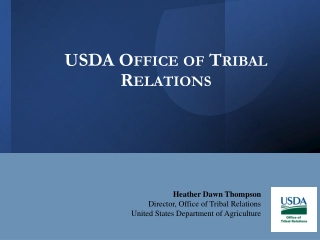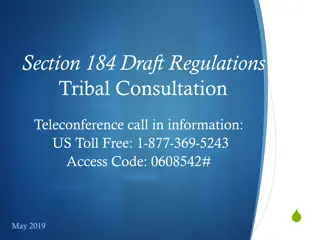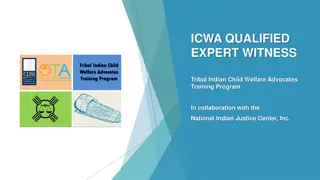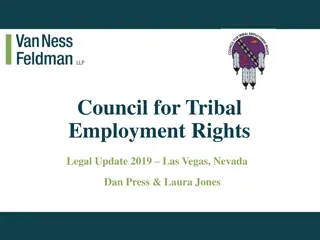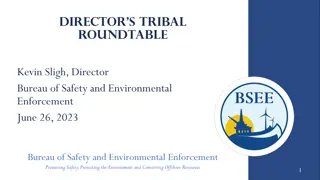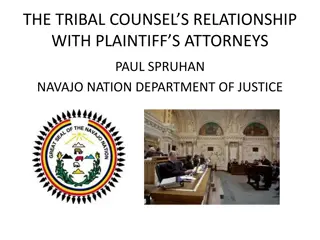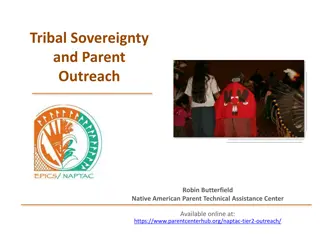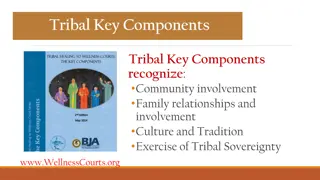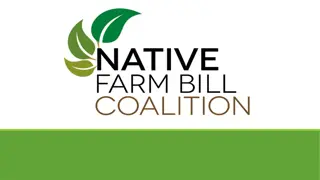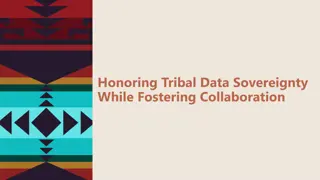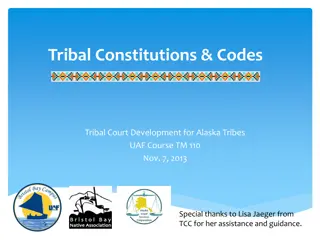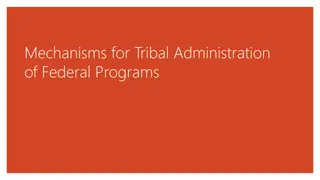Tribal Environmental Laws: Promoting Sovereignty and Protection
Explore the significance of tribal environmental laws in promoting sovereignty and addressing emerging environmental challenges. Delve into the applicability of federal laws in Indian Country, the reasons for enacting tribal environmental laws, and the innovative approaches tribes are taking in environmental governance.
Download Presentation

Please find below an Image/Link to download the presentation.
The content on the website is provided AS IS for your information and personal use only. It may not be sold, licensed, or shared on other websites without obtaining consent from the author. Download presentation by click this link. If you encounter any issues during the download, it is possible that the publisher has removed the file from their server.
E N D
Presentation Transcript
Tribes as Innovative Environmental Laboratories Elizabeth Ann Kronk Warner Assoc. Dean of Academic Affairs, Professor of Law, and Director of Tribal Law and Government Center University of Kansas School of Law November 5, 2015
Presentation Overview Environmental Law Applicable in Indian Country Why Enact Tribal Environmental Laws? Existing Tribal Environmental Laws Types of Tribal Environmental Laws: Delegated Inherent Sovereignty Innovative Differences with Federal Environmental Law Non-Code Sources of Tribal Environmental Law
Environmental Law Applicable in Indian Country Tribal sovereignty Inherent sovereignty over citizens on tribal lands remains Montana implicit divestiture of jurisdiction over non-citizens by virtue of dependent status 2 Exceptions: 1) consensual; or, 2) threat to health and safety of the tribe Following Strate and Hicks, there is an issue as to importance of land status (i.e. tribally-controlled v. non- Indian) States Generally lack authority unless granted by Congress Most states opt to participate in the federal environmental scheme without asserting jurisdiction over Indian country
Environmental Law Applicable in Indian Country, Cont. Federal Law Federal government enacted numerous environmental statutes, especially between 1970 and 1980 It has generally been held that these statutes apply to Indian Country Minimum federal standard will always apply EPA regulates where tribes decline to do so Several statutes, such as the Clean Water Act, allow tribes to be treated as states Tribes with TAS status may enact more stringent regulations ex. City of Albuquerque v. Browner Even if the statute does not specifically grant TAS status, EPA may treat tribes similar to states. RCRA is a notable exception.
Why Enact Tribal Environmental Laws? Tribal Sovereignty and Tribal Environmental Ethics Past Environmental Contamination and Emerging Environmental Challenges Past Contamination Natural Resource Extraction Climate Change
Existing Tribal Environmental Laws Nationwide Reviewed the tribal codes of 74 tribes in four different geographical regions: Arizona, Montana, New York and Oklahoma Looked for four categories of environmental laws: water, air, solid waste and environmental quality Tribes as Innovative Environmental Laboratories , 86 University of Colorado Law Review 789 (2015).
Existing Tribal Environmental Laws Result of Nationwide Survey 4 tribes, 5% of the survey group, enacted air pollution regulations 23 tribes, 31% of the survey group, enacted water pollution regulations 27 tribes, 36% of the survey group, enacted solid waste regulations 9 tribes, 12% of the survey group, enacted environmental quality provisions Overall: Only one tribal nation enacted laws in all four categories studied (possibly two) 38 tribes, 51% of the survey group, do not have any publically available tribal environmental laws 86% (24 out of 28)of the tribes located within the Mountain West (Montana) and Southwest (Arizona) have enacted some tribal environmental law
What about TAS? Tribal Environmental Law Developed Under Delegated Authority Overall, 28 federally recognized tribes, or 5% of total federally recognized tribes, have TAS approval under the CAA Most of these tribes have approval under Section 505(a)(2) Only two tribes have Title V permitting authority Overall, 48 federally recognized tribes, or 8% of federally recognized tribes, have TAS approval under the CWA all under section 303
Takeaways Vast majority of tribal environmental law is not being developed under delegated federal authority There appears to be more interest in utilizing TAS status for the protection of water resources
A Closer Look: Tribal Adoption and Adaptation of Federal Environmental Law In the CAA context: Tribes have largely incorporated the federal standards as codified in the CAA and related regulations Tribes utilizing TAS status under CAA are largely engaged in air quality monitoring, which is reported to EPA and states In the CWA context: A lot of innovation in terms of incorporating tribal customs and spirituality Departures from federal counterparts Reference to Montana exceptions Tribes as Innovative Environmental Laboratories , 86 University of Colorado Law Review 789 (2015).
Innovation through Tribal Sovereignty At most (assuming no overlap), 76 tribes or 13% of federally recognized tribes are utilizing TAS status suggesting that a substantial amount of tribal environmental law is developed under tribal inherent sovereignty Example: Confederated Salish and Kootenai Tribes Climate Change Strategic Plan
Non-Code Sources of Innovation Tribal Constitutions Tribal Customary Law Tribal Vision Statements/Tribal Environmental Ethics Tribal Court Decisions Intertribal Organizations Justice Brandeis and Indian Country: Lessons from the Tribal Environmental Laboratory, Arizona State Law Journal (forthcoming 2015). Available on SSRN at: http://papers.ssrn.com/sol3/papers.cfm?abstract_id=2489211
Additional Information Justice Brandeis and Indian Country: Lessons from the Tribal Environmental Laboratory, Arizona State Law Journal (forthcoming 2015). Available on SSRN at: http://papers.ssrn.com/sol3/papers.cfm?abstra ct_id=2489211 Tribes as Innovative Environmental Laboratories , 86 University of Colorado Law Review 789 (2015). Tribes as Innovative Environmental Laboratories , 86 University of Colorado Law Review 789 (2015).
Miigwetch! (Thank you!) Elizabeth Ann Kronk Warner Assoc. Dean of Academic Affairs, Professor of Law, and Director, Tribal Law and Government Center University of Kansas School of Law (785) 864-1139 elizabeth.kronk@ku.edu


